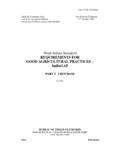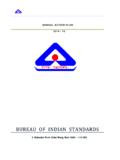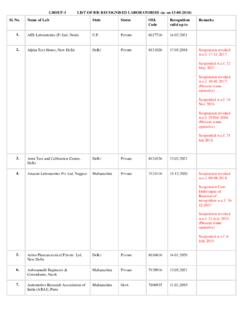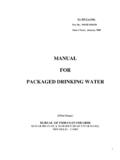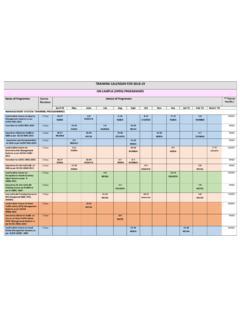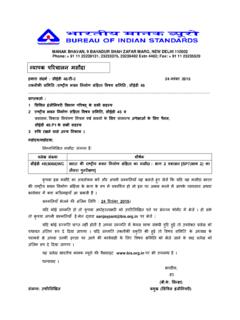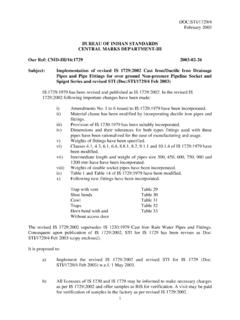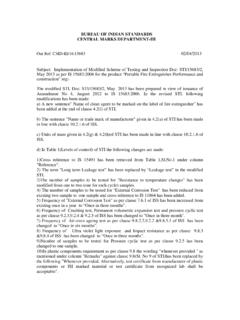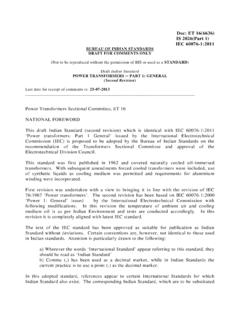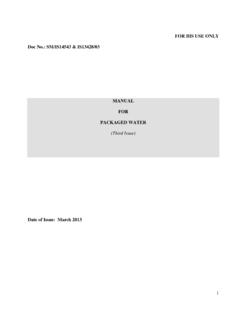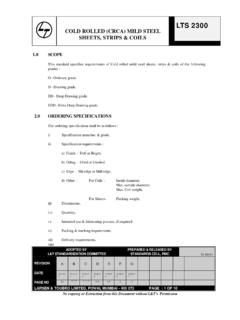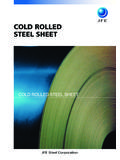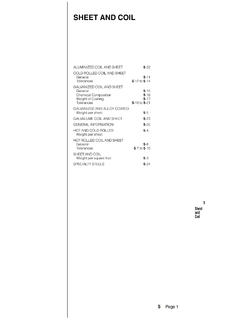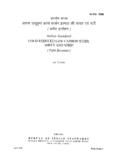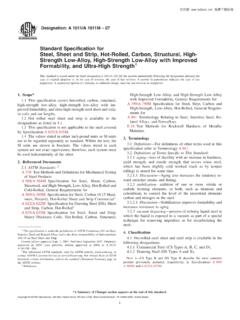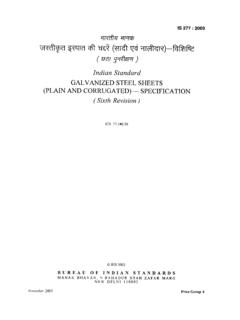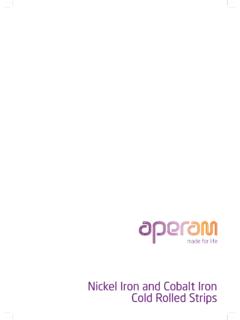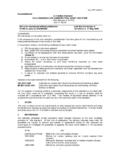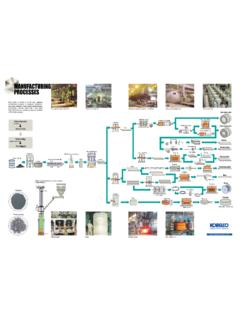Transcription of HOT ROLLED STEEL FLAT PRODUCTS FOR …
1 Doc: MTD 4(4939). For Comments Only Draft Indian Standard HOT ROLLED STEEL FLAT PRODUCTS FOR STRUCTURAL forming AND. flanging PURPOSES specification . ( third Revision of IS 5986). ICS Not to be reproduced without the permission of Last date for receipt of BIS or used as STANDARD comments is 15 June 2009. FOREWORD. (Formal clauses will be added later on). a) Number of grades have been increased to nine. b) Grades have been aligned with the requirements given in the corresponding ISO 20805:2005 Hot ROLLED STEEL sheet in coils of higher yield strength with improved formability and heavy thickness for cold forming . c) International grades designation system based on yield stress has been adopted. d) Clause on retest has been modified. e) Requirements of dimensions and tolerances have been separated from the standard and adopted IS/ISO 7452:2002.
2 For all the tests specified in this standard (chemical/physical/others), the method as specified in relevant ISO Standard may also be followed as an alternate method. For the purpose of deciding whether a particular requirement of this standard is complied with, the final value, observed or calculated, expressing the result of a test or analysis, shall be rounded off in accordance with IS 2:1960 `Rules for rounding off numerical values (revised)'. The number of significant places retained in the rounded off value should be the same as that of the specified value in this standard. 1 SCOPE. This draft standard covers the requirements of hot ROLLED flat PRODUCTS of non-alloy STEEL intended for use in welded, bolted and riveted structures.
3 This standard also covers the requirement of flanging and forming applications required for the manufacture of integral coaches, automobiles and general purpose use where guaranteed mechanical properties and suitability for flanging and forming simple cold pressed parts are necessary. 2 REFERENCES. The following Indian Standards contain provisions, which through reference in this text constitute provisions of this standard. At the time of publication, the editions indicated were valid. All standards are subject to revision and parties to agreements based on this standard are encouraged to investigate the possibility of applying the most recent editions of the standards indicated below: 24. IS No. Title 228 Method for chemical analysis of steels (in various parts).
4 1599:1985 Method for bend test (second revision). 1608. 1730:1989 Dimension for STEEL plate, sheet and strip for structural and general engineering purposes (second revision). 1757:1988 Method for charpy impact test (V-notch) for metallic material (second revision). 1852:1985 Rolling and cutting tolerances for hot ROLLED STEEL product (fourth revision). 1956(Pt 4): Glossary of terms relating to iron and STEEL :Part 4 STEEL sheet 1975 and strip (first revision). 8910:1978 General technical delivery requirements for steels and STEEL PRODUCTS 3 TERMINOLOGY. For the purpose of this standard the definitions given in IS 1956 (Part 4) shall apply. 4 SUPPLY OF MATERIALS. General requirements relating to the supply of material shall conform to IS 8910.
5 5 MANUFACTURE. STEEL shall be manufactured by any process of STEEL making except Bessemer process. It may be followed by secondary refining or secondary vacuum, treatment. STEEL shall be semi killed or killed. 6 GRADE. There shall be eight grades of hot ROLLED STEEL plates, sheets, strips and flats designated as 165, 205,245,325,355,420,490,560. CHEMICAL COMPOSITION. Ladle Analysis Ladle analysis of the material when carried out either by the method specified in the relevant parts of IS 228 or any other established instrumental/chemical method shall be as given in IS 228 and its relevant parts shall be the referee method. However, where the method is not given in IS 228 or its relevant parts, the referee method shall be as agreed to between the purchaser and the manufacturer.
6 Product Analysis The permissible variation in the case of product analysis from the limits specified in Table 1 shall be as given in Table 2. 25. Table 1 Chemical Composition (Clause ). Grade Constituents (Percent), Max Carbon Manganese Phosphorus Sulphur Carbon Equivalent*. (1) (2) (3) (4) (5) (6). 165 -- 205 -- 235 -- 255 325 355 (a) 420 (a) 490 (a) 560 (a) NOTES. 1 The nitrogen content of the STEEL shall not be more than percent. For aluminium killed or aluminium silicon killed the nitrogen content shall not exceed percent. This shall be ensured by occasional checking. 2 When the STEEL is killed by aluminium the total aluminium content should not be less than percent. When STEEL is silicon killed the silicon content shall not be less than percent.
7 When the STEEL is aluminium silicon killed the silicon content shall not be less than percent and total aluminium content shall not be less than percent. 3 The material may be supplied in the copper bearing quality in which case the copper shall be between and percent on analysis. 4 The STEEL can be made with micro alloying element like Nb, V, Ti and B either individually or in combination on mutual agreement. In which case the total micro alloying elements should not exceed percent in ladle analysis. However, in case of boron, the limit shall be percent. 5. As the form of sulfide inclusions may have certain influence on the cold forming properties, STEEL may be treated with elements like Ce or Ca if agreed between the manufacturer and purchaser.
8 (a). For each reduction of below the specified maximum %Carbon, an increase of manganese over the specified maximum up-to is permitted. Mn Cr+Mo+V Ni+Cu *Carbon equivalent (CE) based on ladle analysis = C + ----- + ----------- + ------ 6 5 15. 26. Table 2 Permissible Variation for Product Analysis (Clause ). Constituent Variation Over the Specified Maximum Limit, Percent, Max (1) (2). Carbon Manganese Sulphur Phosphorus Copper 8 FREEDOM FROM DEFECTS. Sheets, strips, plates and flats shall be closely ROLLED to the dimensions specified. The finished material shall be free from harmful defects and shall be reasonable smooth, flat and square. Repair by welding shall not be undertaken by the supplier without the permission of the purchaser.
9 When the material is supplied in the form of coils, the degree or amount of surface defects are expected to be more than in cut length sheets since the inspection of coils does not afford the same opportunity to reject portion continuing defects as with cut lengths. However, an excessive amount of defects may be cause for rejection. In case of plates, scale pits and other minor surface defects may be removed by grinding the depth of grinding being such that the thickness of the plate shall not go below the specified value, at the spot where dressing is done. The grinding shall be even and smooth and shall be widened enough to remove sharp ridges. Dressing with a hammer or welding of defective spots shall not be permitted. 9 TENSILE TEST.
10 One tensile test shall be made from finished STEEL for every 100 tonnes or part thereof ROLLED continuously from each cast. Where plates, sheets, strips and flats of more than one thickness are ROLLED from the same cast, one additional tensile test shall be made from the material: a) In the case of plates and flats for each variation thickness of 6 mm from the thickness of test piece first selected. b) In the case of sheets and strips for each thickness of sheets. Tensile Test Pieces Samples for tensile test shall be cut transverse to the direction of final rolling and shall be of full thickness of the material. Tensile test pieces shall be of dimensions as specified in IS 1608. 27. Tensile Test When tested in accordance with IS 1608 tensile strength, yield strength and percentage elongation shall be as given in Table3.
